RAM 1500 2021 Owners Manual
Manufacturer: RAM, Model Year: 2021, Model line: 1500, Model: RAM 1500 2021Pages: 496, PDF Size: 20.89 MB
Page 471 of 496

TECHNICAL SPECIFICATIONS469
5.7L ENGINE
Do not use E-85 flex fuel or ethanol blends
greater than 15% in this engine.
This engine is designed to meet all
emissions regulations and provide
satisfactory fuel economy and
performance when using high-quality
unleaded gasoline having an octane range of
87 to 89 as specified by the (R+M)/2 method.
The use of 89 octane “Plus” gasoline is
recommended for optimum performance and
fuel economy.
REFORMULATED GASOLINE
Many areas of the country require the use of
cleaner burning gasoline referred to as
“reformulated gasoline”. Reformulated
gasoline contains oxygenates and are
specifically blended to reduce vehicle
emissions and improve air quality.
The use of reformulated gasoline is
recommended. Properly blended reformulated
gasoline will provide improved performance
and durability of engine and fuel system
components.
MATERIALS ADDED TO FUEL
Besides using unleaded gasoline with the
proper octane rating, gasolines that contain
detergents, corrosion and stability additives are
recommended. Using gasolines that have these
additives will help improve fuel economy,
reduce emissions, and maintain vehicle
performance.
Designated TOP TIER Detergent
Gasoline contains a higher level of
detergents to further aide in
minimizing engine and fuel system
deposits. When available, the usage of TOP
TIER Detergent Gasoline is recommended. Visit
www.toptiergas.com for a list of TOP TIER
Detergent Gasoline retailers.
Indiscriminate use of fuel system cleaning
agents should be avoided. Many of these
materials intended for gum and varnish
removal may contain active solvents or similar
ingredients. These can harm fuel system gasket
and diaphragm materials.
GASOLINE/OXYGENATE BLENDS
Some fuel suppliers blend unleaded gasoline
with oxygenates such as ethanol.
Problems that result from using gasoline
containing more than 15% ethanol (E-15) or
gasoline containing methanol are not the
responsibility of FCA and may void the New
Vehicle Limited Warranty.
CAUTION!
DO NOT use E-85, gasoline containing
methanol, or gasoline containing more than
15% ethanol (E-15). Use of these blends may
result in starting and drivability problems,
damage critical fuel system components,
cause emissions to exceed the applicable
standard, and/or cause the Malfunction
Indicator Light to illuminate. Please observe
pump labels as they should clearly
communicate if a fuel contains greater than
15% ethanol (E-15).
9
21_DT_OM_EN_USC_t.book Page 469
Page 472 of 496

470TECHNICAL SPECIFICATIONS
(Continued)
DO NOT USE E-85 IN NON-FLEX FUEL
V
EHICLES
Non-Flex Fuel Vehicles (FFV) are compatible
with gasoline containing up to 15% ethanol
(E-15). Use of gasoline with higher ethanol
content may void the New Vehicle Limited
Warranty.
If a Non-FFV vehicle is inadvertently fueled with
E-85 fuel, the engine will have some or all of
these symptoms:
Operate in a lean mode.
OBD II Malfunction Indicator Light on.
Poor engine performance.
Poor cold start and cold drivability.
Increased risk for fuel system component
corrosion.
CNG AND LP FUEL SYSTEM
M
ODIFICATIONS
Modifications that allow the engine to run on
Compressed Natural Gas (CNG) or Liquid
Propane (LP) may result in damage to the
engine, emissions, and fuel system
components. Problems that result from running CNG or LP are not the responsibility of FCA and
may void the New Vehicle Limited Warranty.
METHYLCYCLOPENTADIENYL
M
ANGANESE TRICARBONYL (MMT) IN
G
ASOLINE
MMT is a manganese-containing metallic
additive that is blended into some gasoline to
increase octane. Gasoline blended with MMT
provides no performance advantage beyond
gasoline of the same octane number without
MMT. Gasoline blended with MMT reduces
spark plug life and reduces emissions system
performance in some vehicles. FCA
recommends that gasoline without MMT be
used in your vehicle. The MMT content of
gasoline may not be indicated on the gasoline
pump; therefore, you should ask the gasoline
retailer whether the gasoline contains MMT.
MMT is prohibited in Federal and California
reformulated gasoline.
FUEL SYSTEM CAUTIONS
NOTE:
Intentional tampering with the emissions
control system can result in civil penalties being
assessed against you.CAUTION!
Follow these guidelines to maintain your
vehicle’s performance:
The use of leaded gasoline is prohibited by
Federal law. Using leaded gasoline can
impair engine performance and damage
the emissions control system.
An out-of-tune engine or certain fuel or igni -
tion malfunctions can cause the catalytic
converter to overheat. If you notice a
pungent burning odor or some light smoke,
your engine may be out of tune or malfunc -
tioning and may require immediate service.
Contact an authorized dealer for service
assistance.
The use of fuel additives, which are now
being sold as octane enhancers, is not
recommended. Most of these products
contain high concentrations of methanol.
Fuel system damage or vehicle perfor -
mance problems resulting from the use of
such fuels or additives is not the responsi -
bility of FCA and may void or not be covered
under the New Vehicle Limited Warranty.
CAUTION! (Continued)
21_DT_OM_EN_USC_t.book Page 470
Page 473 of 496

TECHNICAL SPECIFICATIONS471
FUEL REQUIREMENTS – DIESEL ENGINE
Federal law requires that you must fuel this
vehicle with Ultra Low Sulfur Highway Diesel
fuel (15 ppm Sulfur maximum) and prohibits
the use of Low Sulfur Highway Diesel fuel
(500 ppm Sulfur maximum) to avoid damage to
the emissions control system.
Use good quality diesel fuel from a reputable
supplier in your vehicle. For most year-round
service, No. 2 diesel fuel meeting ASTM
(formerly known as the American Society for
Testing and Materials) specification D-975
Grade S15 will provide good performance. If the
vehicle is exposed to extreme cold (below 20°F
or -7°C), or is required to operate at
colder-than-normal conditions for prolonged
periods, use Climatized Number 2 diesel fuel or
dilute the Number 2 diesel fuel with 50%
Number 1 diesel fuel. This will provide better
protection from fuel gelling or wax-plugging of
the fuel filters. Diesel fuel is seldom completely free of water.
To prevent fuel system trouble, drain the
accumulated water from the fuel/water
separator filter using the fuel/water separator
drain provided on the fuel filter housing. If you
buy good quality fuel and follow the cold
weather advice above, fuel conditioners should
not be required in your vehicle. If available in
your area, a high cetane “premium” diesel fuel
may offer improved cold-starting and warm-up
performance.
DIESEL FUEL SPECIFICATIONS
This diesel engine has been developed to take
advantage of the high energy content and
generally lower cost Number 2 Ultra Low Sulfur
diesel fuel or Number 2 Ultra Low Sulfur
Climatized diesel fuels.
NOTE:
If you accidentally fill the fuel tank with gaso
-
line on your diesel vehicle, do not start the
engine. Damage to the engine and fuel
system could occur. Please call an autho -
rized dealer for service.
A maximum blend of 5% biodiesel meeting
ASTM specification D-975 may be used with
your diesel engine without any adjustments
to regular service schedules.
Commercially available fuel additives are not
necessary for the proper operation of your
diesel engine.
Number 1 Ultra Low Sulfur diesel fuel should
only be used where extended arctic condi -
tions (-10°F or -23°C) exist.
WARNING!
Do not use alcohol or gasoline as a fuel
blending agent. They can be unstable under
certain conditions and hazardous or
explosive when mixed with diesel fuel.
CAUTION!
If the “Water in Fuel Indicator Light” remains
on, DO NOT START engine before you drain
the water from the fuel filter(s) to avoid
engine damage Ú page 412.9
21_DT_OM_EN_USC_t.book Page 471
Page 474 of 496

472TECHNICAL SPECIFICATIONS
BIODIESEL FUEL REQUIREMENTS
A maximum blend of 5% biodiesel meeting
ASTM specification D975 is recommended for
use with your diesel engine. If frequent
operation with Biodiesel blends that are
between 6% and 20% (B6–B20) is desired, the
maintenance schedule is subject to shorter
intervals.
The oil and filter change along with fuel filter
replacement is subject to shorter intervals
when operating your engine on biodiesel
greater than 5%. Do not use biodiesel greater
than 20%.
For regular use of biodiesel blends between 6%
and 20% (B6–B20) it is important that you
understand and comply with these
requirements. For further direction
Úpage 403. Biodiesel is a fuel produced from renewable
resources typically derived from animal fat,
rapeseed oil (Rapeseed Methyl Ester (RME)
base), or soybean oil (Soy Methyl Ester (SME or
SOME) base).
Biodiesel fuel has inherent limitations which
require that you understand and adhere to the
following requirements if you use blends of
Biodiesel between 6% and 20% (B6–B20).
There are no unique restrictions for the use of
B5.
Biodiesel Fuel Properties — Low Ambient
Temperatures
Biodiesel fuel may gel or solidify at low ambient
temperatures, which may pose problems for
both storage and operation. Precautions can be
necessary at low ambient temperatures, such
as storing the fuel in a heated building or a
heated storage tank, or using cold temperature
additives.
CAUTION!
Failure to comply with Oil Change
requirements for vehicles operating on
biodiesel blends between 6% and 20%
(B6–B20) will result in premature engine
wear. Such wear is not covered by the New
Vehicle Limited Warranty.
CAUTION!
Use of blends greater than 20% is not
approved. Use of blends greater than 20%
can result in engine damage. Such damage is
not covered by the New Vehicle Limited
Warranty.
CAUTION!
In the event that the vehicle is filled with
biodiesel and not used for more than a
month, the fuel should either be used up by
driving (up to quarter tank) and filled with
standard diesel blends with less than 5% that
is normally available. This will help prevent
the fuel filter clogging and potential damage
to the fuel injection system due to degraded
biodiesel, which is not covered by the New
Vehicle Limited Warranty.
21_DT_OM_EN_USC_t.book Page 472
Page 475 of 496

TECHNICAL SPECIFICATIONS473
Fuel Quality — Must Comply With ASTM
Standards
The quality of Biodiesel fuel may vary widely.
Only fuel produced by a BQ9000 supplier to the
following specifications may be blended to
meet Biodiesel blend B6 – B20 fuel meeting
ASTM specification D-7467:
Petrodiesel fuel meeting ASTM specification
D-975 and Biodiesel fuel (B100) meeting ASTM
specification D-6751
Fuel Oxidation Stability — Must Use Fuel
Within Six Months Of Manufacture
Biodiesel fuel has poor oxidation stability which
can result in long term storage problems. Fuel
produced to approved ASTM standards, if
stored properly, provides for protection against
fuel oxidation for up to six months.
Fuel Water Separation — Must Use Mopar
Approved Fuel Filter Elements
Biodiesel fuel has a natural affinity to water and
water accelerates microbial growth. Your Mopar
filtration system is designed to provide
adequate fuel water separation capabilities.
Fuel In Oil Dilution — Must Adhere To
Required Oil Change Interval
Fuel dilution of lubricating oil has been
observed with the use of Biodiesel fuel. Fuel in
oil must not exceed 5%. To ensure this limit is
met your oil change interval must be
maintained with in the suggested schedule. The
regular use of biodiesel between 6% and 20%
requires intervals shorter than the outlined
10,000 miles (16,100 km) and must not
exceed the suggested schedule. When routinely
operating on biodiesel between 6% and 20%, oil
and filter replacement intervals must not
exceed 8,000 Miles (12,900 km) or six months,
which ever comes first.
Biodiesel Fuel Filter Change Intervals
The use of biodiesel requires more frequent fuel
filter change intervals. When operating on
biodiesel between 6% and 20%, fuel filter
replacement intervals should be every second
oil change, and must not exceed 16,000 miles
(25,750 km).
NOTE:
Under no circumstances should oil change
intervals exceed 8,000 miles (12,875 km) or
six months, if regular operation occurs with 6%
- 20% biodiesel blends. Under no circumstances
should fuel filter replacement intervals exceed
every second oil change and must not exceed
16,000 miles (25,750 km), if regular operation
occurs with 6% - 20% biodiesel blends. Failure
to comply with these oil change and fuel filter
requirements for vehicles operating on
biodiesel blends up to B20 may result in prema -
ture engine wear. Such wear is not covered by
the New Vehicle Limited Warranty. The engine
may suffer severe damage if operated with
concentrations of biodiesel higher than 20%.
9
21_DT_OM_EN_USC_t.book Page 473
Page 476 of 496
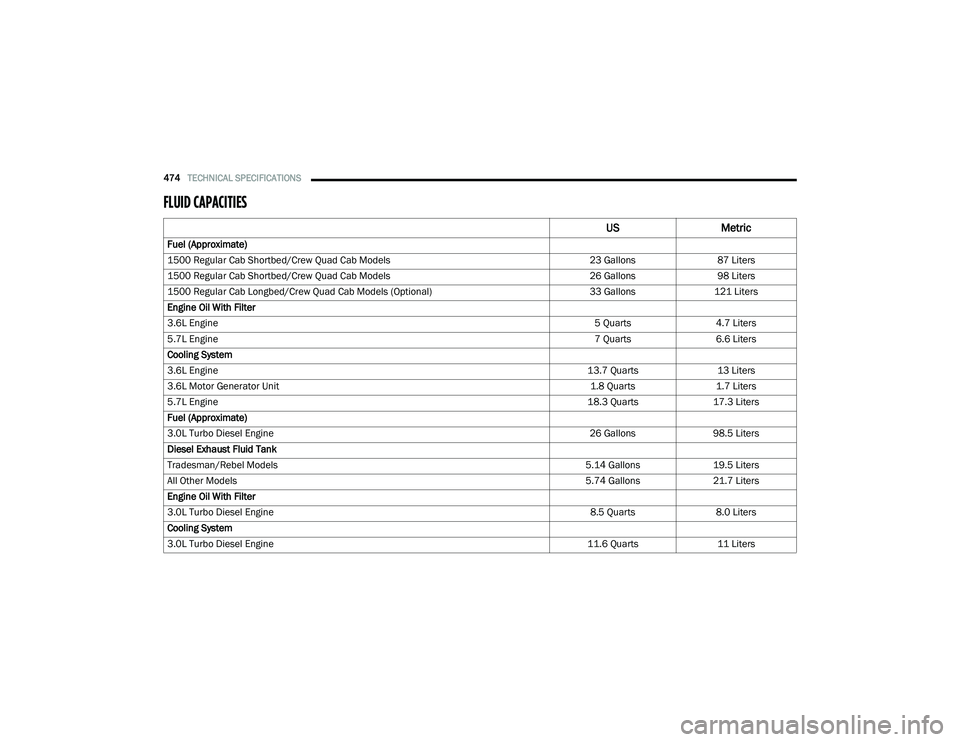
474TECHNICAL SPECIFICATIONS
FLUID CAPACITIES
USMetric
Fuel (Approximate)
1500 Regular Cab Shortbed/Crew Quad Cab Models 23 Gallons87 Liters
1500 Regular Cab Shortbed/Crew Quad Cab Models 26 Gallons98 Liters
1500 Regular Cab Longbed/Crew Quad Cab Models (Optional) 33 Gallons121 Liters
Engine Oil With Filter
3.6L Engine 5 Quarts4.7 Liters
5.7L Engine 7 Quarts6.6 Liters
Cooling System
3.6L Engine 13.7 Quarts13 Liters
3.6L Motor Generator Unit 1.8 Quarts1.7 Liters
5.7L Engine 18.3 Quarts17.3 Liters
Fuel (Approximate)
3.0L Turbo Diesel Engine 26 Gallons98.5 Liters
Diesel Exhaust Fluid Tank
Tradesman/Rebel Models 5.14 Gallons19.5 Liters
All Other Models 5.74 Gallons21.7 Liters
Engine Oil With Filter
3.0L Turbo Diesel Engine 8.5 Quarts8.0 Liters
Cooling System
3.0L Turbo Diesel Engine 11.6 Quarts11 Liters
21_DT_OM_EN_USC_t.book Page 474
Page 477 of 496
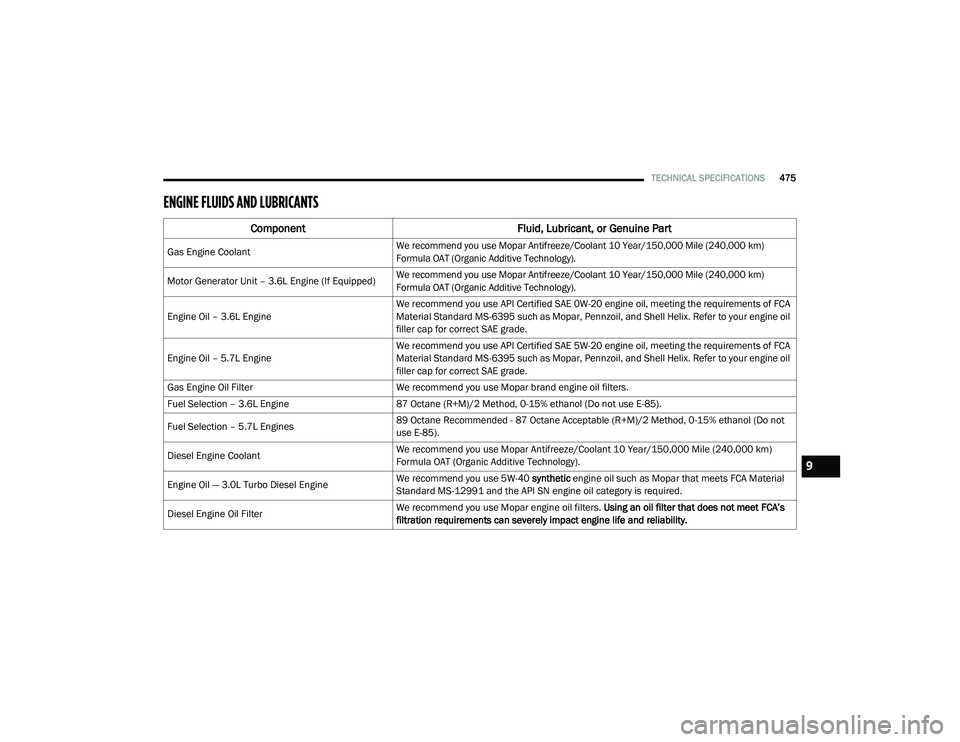
TECHNICAL SPECIFICATIONS475
ENGINE FLUIDS AND LUBRICANTS
Component Fluid, Lubricant, or Genuine Part
Gas Engine CoolantWe recommend you use Mopar Antifreeze/Coolant 10 Year/150,000 Mile (240,000 km)
Formula OAT (Organic Additive Technology).
Motor Generator Unit – 3.6L Engine (If Equipped) We recommend you use Mopar Antifreeze/Coolant 10 Year/150,000 Mile (240,000 km)
Formula OAT (Organic Additive Technology).
Engine Oil – 3.6L Engine We recommend you use API Certified SAE 0W-20 engine oil, meeting the requirements of FCA
Material Standard MS-6395 such as Mopar, Pennzoil, and Shell Helix. Refer to your engine oil
filler cap for correct SAE grade.
Engine Oil – 5.7L Engine We recommend you use API Certified SAE 5W-20 engine oil, meeting the requirements of FCA
Material Standard MS-6395 such as Mopar, Pennzoil, and Shell Helix. Refer to your engine oil
filler cap for correct SAE grade.
Gas Engine Oil Filter We recommend you use Mopar brand engine oil filters.
Fuel Selection – 3.6L Engine 87 Octane (R+M)/2 Method, 0-15% ethanol (Do not use E-85).
Fuel Selection – 5.7L Engines 89 Octane Recommended - 87 Octane Acceptable (R+M)/2 Method, 0-15% ethanol (Do not
use E-85).
Diesel Engine Coolant We recommend you use Mopar Antifreeze/Coolant 10 Year/150,000 Mile (240,000 km)
Formula OAT (Organic Additive Technology).
Engine Oil — 3.0L Turbo Diesel Engine We recommend you use 5W-40
synthetic engine oil such as Mopar that meets FCA Material
Standard MS-12991 and the API SN engine oil category is required.
Diesel Engine Oil Filter We recommend you use Mopar engine oil filters.
Using an oil filter that does not meet FCA’s
filtration requirements can severely impact engine life and reliability.
9
21_DT_OM_EN_USC_t.book Page 475
Page 478 of 496
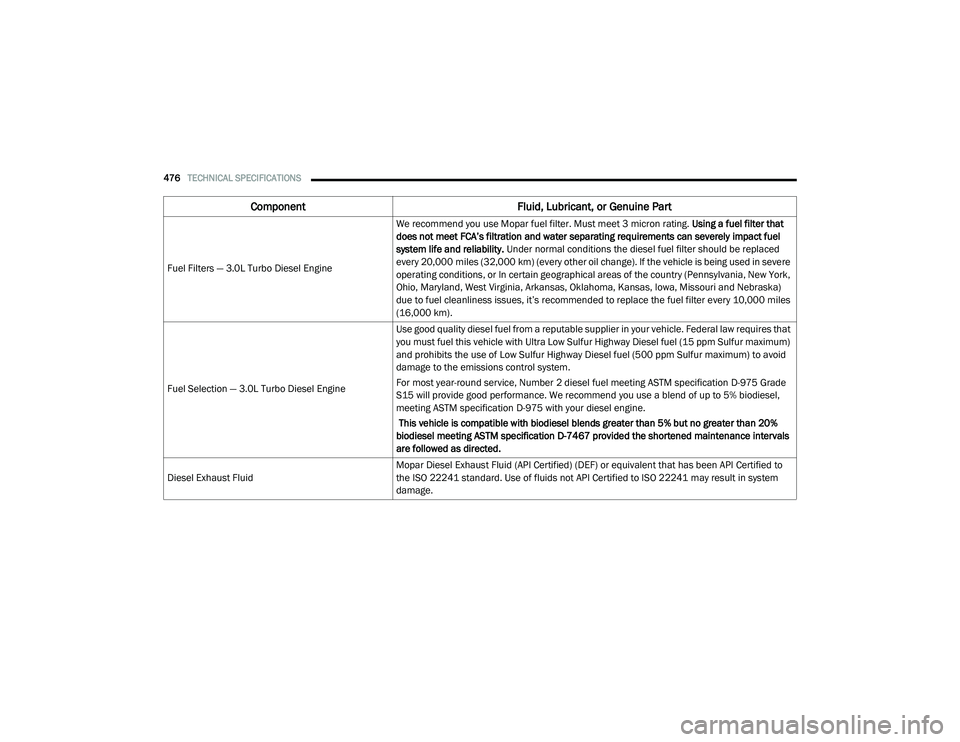
476TECHNICAL SPECIFICATIONS
Fuel Filters — 3.0L Turbo Diesel Engine We recommend you use Mopar fuel filter. Must meet 3 micron rating. Using a fuel filter that
does not meet FCA’s filtration and water separating requirements can severely impact fuel
system life and reliability.
Under normal conditions the diesel fuel filter should be replaced
every 20,000 miles (32,000 km) (every other oil change). If the vehicle is being used in severe
operating conditions, or In certain geographical areas of the country (Pennsylvania, New York,
Ohio, Maryland, West Virginia, Arkansas, Oklahoma, Kansas, Iowa, Missouri and Nebraska)
due to fuel cleanliness issues, it’s recommended to replace the fuel filter every 10,000 miles
(16,000 km).
Fuel Selection — 3.0L Turbo Diesel Engine Use good quality diesel fuel from a reputable supplier in your vehicle. Federal law requires that
you must fuel this vehicle with Ultra Low Sulfur Highway Diesel fuel (15 ppm Sulfur maximum)
and prohibits the use of Low Sulfur Highway Diesel fuel (500 ppm Sulfur maximum) to avoid
damage to the emissions control system.
For most year-round service, Number 2 diesel fuel meeting ASTM specification D-975 Grade
S15 will provide good performance. We recommend you use a blend of up to 5% biodiesel,
meeting ASTM specification D-975 with your diesel engine.
This vehicle is compatible with biodiesel blends greater than 5% but no greater than 20%
biodiesel meeting ASTM specification D-7467 provided the shortened maintenance intervals
are followed as directed.
Diesel Exhaust Fluid Mopar Diesel Exhaust Fluid (API Certified) (DEF) or equivalent that has been API Certified to
the ISO 22241 standard. Use of fluids not API Certified to ISO 22241 may result in system
damage.
Component
Fluid, Lubricant, or Genuine Part
21_DT_OM_EN_USC_t.book Page 476
Page 479 of 496
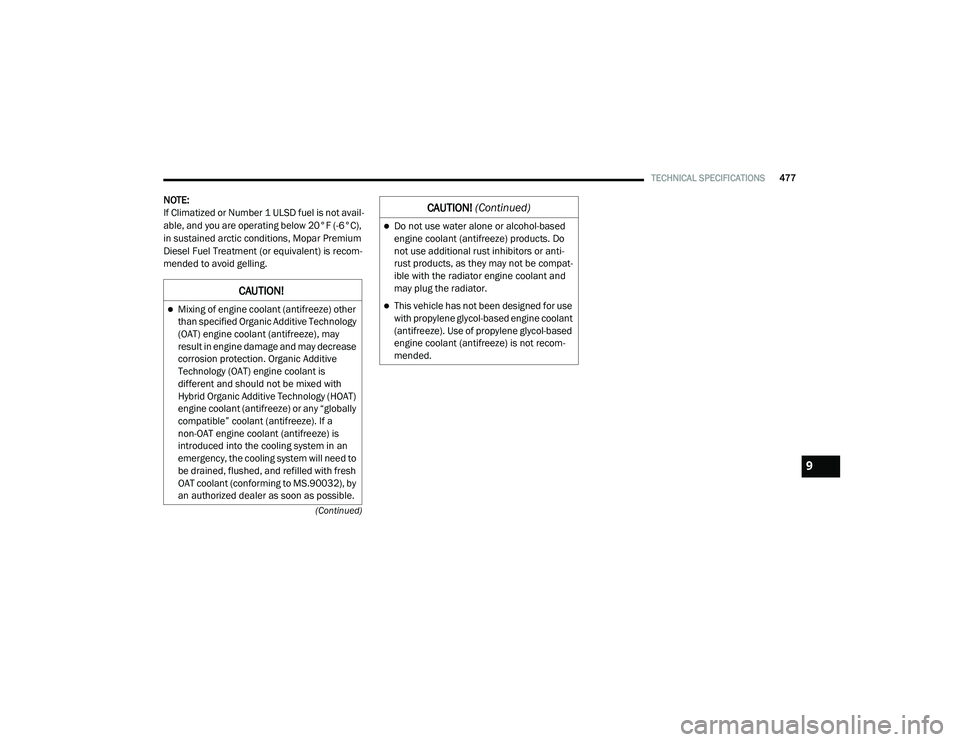
TECHNICAL SPECIFICATIONS477
(Continued)
NOTE:
If Climatized or Number 1 ULSD fuel is not avail -
able, and you are operating below 20°F (-6°C),
in sustained arctic conditions, Mopar Premium
Diesel Fuel Treatment (or equivalent) is recom -
mended to avoid gelling.
CAUTION!
Mixing of engine coolant (antifreeze) other
than specified Organic Additive Technology
(OAT) engine coolant (antifreeze), may
result in engine damage and may decrease
corrosion protection. Organic Additive
Technology (OAT) engine coolant is
different and should not be mixed with
Hybrid Organic Additive Technology (HOAT)
engine coolant (antifreeze) or any “globally
compatible” coolant (antifreeze). If a
non-OAT engine coolant (antifreeze) is
introduced into the cooling system in an
emergency, the cooling system will need to
be drained, flushed, and refilled with fresh
OAT coolant (conforming to MS.90032), by
an authorized dealer as soon as possible.
Do not use water alone or alcohol-based
engine coolant (antifreeze) products. Do
not use additional rust inhibitors or anti-
rust products, as they may not be compat -
ible with the radiator engine coolant and
may plug the radiator.
This vehicle has not been designed for use
with propylene glycol-based engine coolant
(antifreeze). Use of propylene glycol-based
engine coolant (antifreeze) is not recom -
mended.
CAUTION! (Continued)
9
21_DT_OM_EN_USC_t.book Page 477
Page 480 of 496
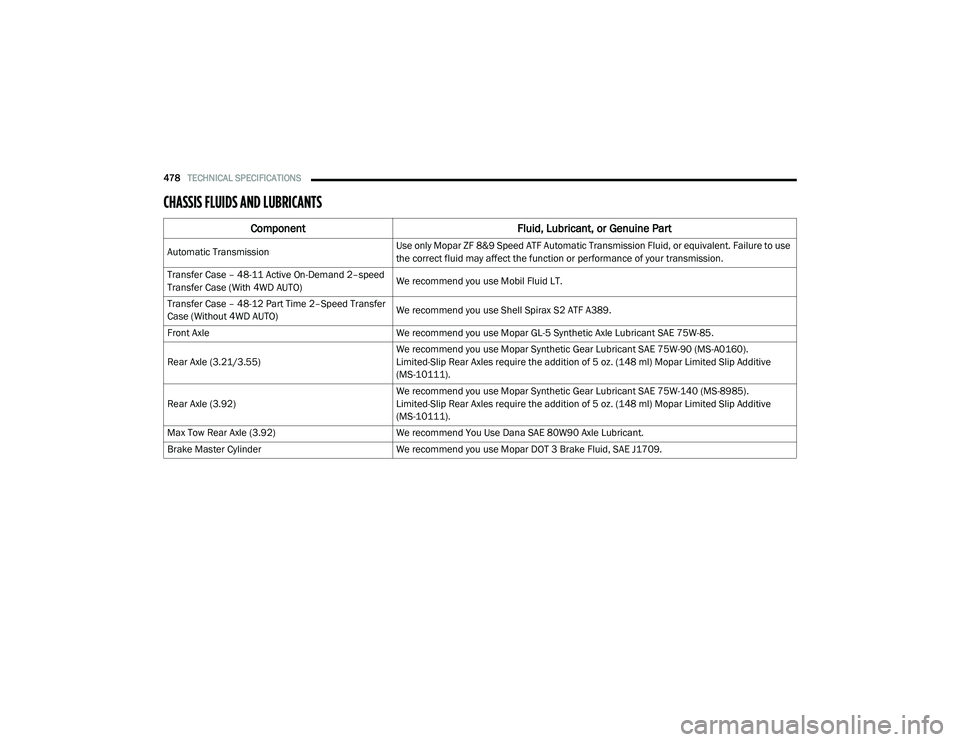
478TECHNICAL SPECIFICATIONS
CHASSIS FLUIDS AND LUBRICANTS
Component Fluid, Lubricant, or Genuine Part
Automatic TransmissionUse only Mopar ZF 8&9 Speed ATF Automatic Transmission Fluid, or equivalent. Failure to use
the correct fluid may affect the function or performance of your transmission.
Transfer Case – 48-11 Active On-Demand 2–speed
Transfer Case (With 4WD AUTO) We recommend you use Mobil Fluid LT.
Transfer Case – 48-12 Part Time 2–Speed Transfer
Case (Without 4WD AUTO) We recommend you use Shell Spirax S2 ATF A389.
Front Axle We recommend you use Mopar GL-5 Synthetic Axle Lubricant SAE 75W-85.
Rear Axle (3.21/3.55) We recommend you use Mopar Synthetic Gear Lubricant SAE 75W-90 (MS-A0160).
Limited-Slip Rear Axles require the addition of 5 oz. (148 ml) Mopar Limited Slip Additive
(MS-10111).
Rear Axle (3.92) We recommend you use Mopar Synthetic Gear Lubricant SAE 75W-140 (MS-8985).
Limited-Slip Rear Axles require the addition of 5 oz. (148 ml) Mopar Limited Slip Additive
(MS-10111).
Max Tow Rear Axle (3.92) We recommend You Use Dana SAE 80W90 Axle Lubricant.
Brake Master Cylinder We recommend you use Mopar DOT 3 Brake Fluid, SAE J1709.
21_DT_OM_EN_USC_t.book Page 478